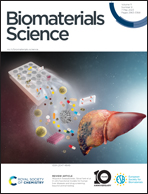Optimization of magnetic nanoparticles for engineering erythrocytes as theranostic agents†
Abstract
The application of superparamagnetic iron oxide nanoparticles (SPIONs) in drug delivery, magnetic resonance imaging, cell tracking, and hyperthermia has been long exploited regarding their inducible magnetic properties. Nevertheless, SPIONs remain rapidly cleared from the circulation by the reticuloendothelial system (RES) or mononuclear phagocyte system, with uptake dependent on several factors such as the hydrodynamic diameter, electrical charge and surface coating. This rapid clearance of SPION-based theranostic agents from circulation is one of the main challenges hampering the medical applications that differ from RES targeting. This work proposes a strategy to render biocompatible SPIONs through their encapsulation in the red blood cells (RBCs). In this work, the research has been focused on the multi-step optimization of chemical synthesis of magnetic nanoparticles (MNPs), precisely iron oxide nanoparticles (IONPs) and zinc manganese-ferrite nanoparticles (Zn/Mn FNPs), for encapsulation in human and murine RBCs. The encapsulation through the transient opening of RBC membrane pores requires extensive efforts to deliver high-quality nanoparticles in terms of chemical properties, morphology, stability and biocompatibility. After reaching this goal, in vitro experiments were performed with selected nanomaterials to investigate the potential of engineered MNP-RBC constructs in theranostic approaches.



 Please wait while we load your content...
Please wait while we load your content...